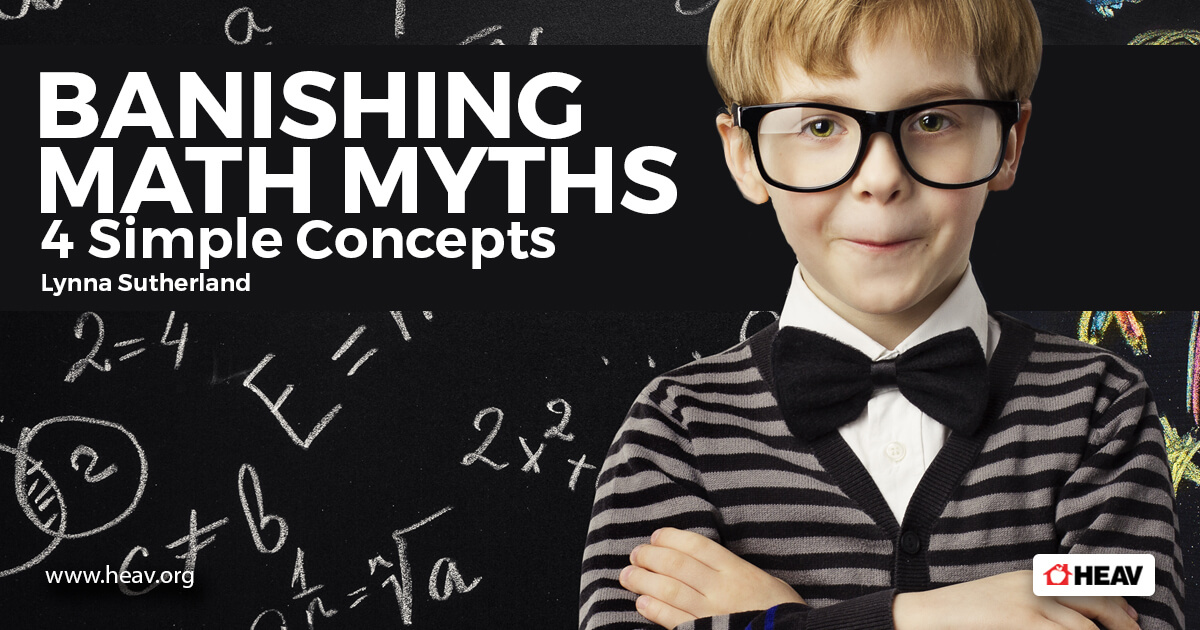Banishing Math Myths
I’ve talked to a lot of homeschool moms. And I know that one thing many homeschool moms fear—one area in which they feel uncertain and insufficient—is in math instruction. Sometimes moms fear concepts they themselves do not understand. Sometimes they fear being unable to explain tricky ideas or skills. And sometimes, they fear mutiny or tears when the kids are overwhelmed by math lessons!
A Bad Math Loop
Another math struggle is trying to keep up with multiple children in multiple different grade levels. This was our struggle. Math became a perpetual cycle of doing worksheets, checking worksheets, correcting worksheets, and checking worksheets again.
My son, the natural math thinker, began to say that he hated math, even that he was “bad at math.” To him, “math” meant reviewing, over and over, the same horrendously tedious long-division problem, trying to find that one digit he forgot to carry, that one multiplication problem he missed by ten.
There was no time for hands-on math. No “living math.” No fractions by cookie baking and money by grocery shopping. In a nutshell, none of the things that I imagined being a part of homeschool math were actually happening. Math time was dominated by workbooks. And frustration.
A Perspective Flip
Homeschool families feel the crunch when it comes to math. We’ve been indoctrinated with the idea that it’s imperative not to get “behind” in math in the early years. If we don’t do the first grade stuff in first grade, we can’t do the second grade stuff in second grade, the third grade stuff in third grade, and so on.
But we’re already behind the curve, actually. Eighty years ago, (then superintendent of schools in Manchester, New Hampshire) conducted an experiment. You can read more about it here, but the summary is that he found that all of arithmetic could be taught in one year (in sixth grade), and that students who delayed formal math instruction until then often ended up with at least an equivalent grasp of calculation and usually a superior grasp of problem-solving.
Even if we aren’t comfortable with delaying formal math instruction until middle school, think about the perspective this lends. What if you don’t finish a textbook? What if you “miss” some concepts one year? What if a concept proves too challenging and you let it go for a while? If all of arithmetic could be taught to a developmentally ready sixth grader, doesn’t that at least remove some of the pressure from a homeschool mom of elementary kids?
Buying Local
A friend introduced me (online) to Carlita Boyles, a fellow Virginia homeschool mom, and her philosophy of math instruction. She is just about to graduate her youngest. But when her children were in the thick of the elementary years and studying arithmetic, she realized something. Math is sequential in some ways. But in many ways, it is simply developmental.
In other words, we think that working on more complex arithmetic depends merely on getting the “stuff that comes before it” done. In fact, it depends on a child being developmentally ready to learn it. Pouring energy into teaching a skill to a child who isn’t mentally mature enough to grasp it is like pushing harder on the gas when your tires are spinning in the mud. You don’t make forward progress, and you may just be digging a bigger hole.
Carlita gathered up all of her textbooks. She researched. She looked over scope-and-sequences. And she made a list of all of the things that kids needed to learn in order to be ready for algebra. She determined that through the end of pre-algebra, students need to learn four basic things:
- Operations (addition, subtraction, multiplication, division)
- Money and Decimals
- Fractions
- Geometry and Measurement
And even if you break those four basic concepts down into smaller skills, there are only roughly 150 topics to cover by the end of seventh or eighth grade. Only 150 topics to cover in eight or nine years of schooling! Carlita has compiled her system into a program called Math on the Level, which is unlike any math curriculum you’ve seen before. Instead of a book per grade, she has a book per concept (the four listed above) plus a well-oiled system of record keeping and some other supplemental resources.
Family Math
With this perspective on math, I no longer have to teach my children in “grade levels.” I just need to spend some time on each of the four concepts each year. We can learn together as a family. Hands-on exploration is no problem. And then they can all work on review (very briefly) independently, at their own level.
Lynna Sutherland blogs at Homeschooling Without Training Wheels, where she loves to remind moms (and herself!) of the freedom and flexibility that come with homeschooling! Lynna and her husband have seven children. The motto of their homeschool is “Wisdom Is the Principal Thing” from Proverbs 4:7. You can follow Lynna on Instagram, Facebook, and Pinterest.
Like this post? Read more math articles here.








